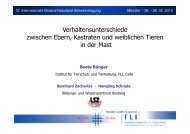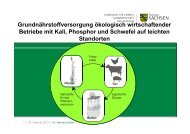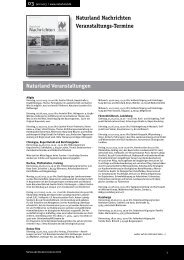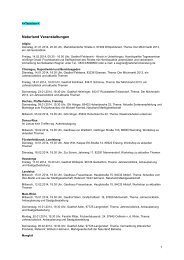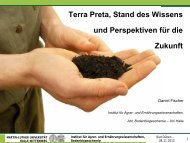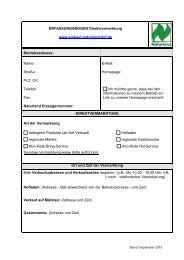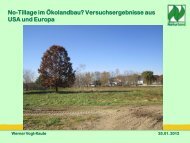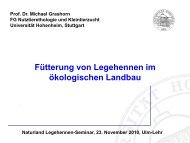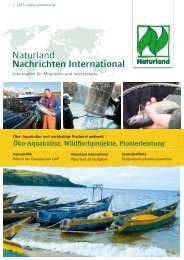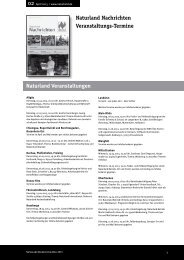Organic Farming in the Tropics and Subtropics: Sesame - Naturland
Organic Farming in the Tropics and Subtropics: Sesame - Naturland
Organic Farming in the Tropics and Subtropics: Sesame - Naturland
You also want an ePaper? Increase the reach of your titles
YUMPU automatically turns print PDFs into web optimized ePapers that Google loves.
II Special section: <strong>Organic</strong> Cultivation of <strong>Sesame</strong><br />
Appendix<br />
Examples of varieties 28 :<br />
Early ripen<strong>in</strong>g varieties: “Madhavi”, “B 67”, “Kanak”, “GT 1”, “Tapi”, “TMV 3”, “TMV<br />
5”, “SI 36”, “ES 6”, “ES 43”, “ES 41-3-84” <strong>and</strong> “IS 234-2-84” (India, Russia, Ch<strong>in</strong>a).<br />
Varieties suitable for dryl<strong>and</strong> farm<strong>in</strong>g: “JT 66- 135”, “JT 7”, “Type 4”, “Gujarat<br />
Selection 12”, “Type 12” <strong>and</strong> “Type 13” (India).<br />
Varieties with improved capsules, seeds <strong>and</strong> oil content: Varieties with multiple<br />
capsules <strong>in</strong>clude: “Purva 1”, “Patan 64” <strong>and</strong> “M 32” (India).<br />
Varieties with nonscatter<strong>in</strong>g capsules: “S.I.152”, “Delco”, “Rio” <strong>and</strong> “Palmetto”<br />
(USA).<br />
Varieties with large seeds: “Phule Til 1” <strong>and</strong> “JT 7”.<br />
Varieties with a high oil content: “TMV 5”, “TMV 6” <strong>and</strong> “Aceiterad”, as well as,<br />
generally, <strong>the</strong> types with white seeds.<br />
High yield varieties: The objective here is to move away from <strong>the</strong> bushy varieties –<br />
which are adapted to low soil fertility <strong>and</strong> rough wea<strong>the</strong>r conditions – <strong>and</strong> towards<br />
<strong>the</strong> non-branch<strong>in</strong>g, s<strong>in</strong>gle stem varieties which have several capsules on each axil.<br />
They allow a higher density to be planted, which leads to higher yields <strong>and</strong> easier<br />
management.<br />
Two Indian varieties are: “Pratap” <strong>and</strong> “N 32”.<br />
Varieties which are disease <strong>and</strong> pest resistant: (Lal <strong>and</strong> Rai; Kolte)<br />
Alternaria leaf spot -resistant: wholly hairy varieties, as well as “SI 948“, “SI-1561”,<br />
“1683”, “1737”, “2177”, “2381” <strong>and</strong> “Rio”.<br />
-tolerant: “Sirogoma”, “Venezuela 51”, “NO 4”, “E 8”, “JT 7”, “JT63-117”, “A-6-5”,<br />
“JT-66-276”, “An<strong>and</strong>-9”, “JT-62-10”, “VT-43” <strong>and</strong> An<strong>and</strong> 74.<br />
Bacterial blight-resistant: “T-58”.<br />
Bacterial leaf spot -resistant: “Dulce”, “Margo”, “Early Russian” (<strong>the</strong> latter also<br />
aga<strong>in</strong>st Rasse 2).<br />
India: “Almora local white”, “Punjab 1”, “C23”, “MP 8”, “M3-1”, “EC (4090, 13536,<br />
14538, 20783, 20785 <strong>and</strong> 20787)”.<br />
28 LAL, J.P., <strong>and</strong> RAI, B. (1991): sesame um: an all-season oilseed crop. Indian <strong>Farm<strong>in</strong>g</strong> 41 (5).<br />
KOLTE, S.J. (1985): Diseases of annual edible oilseed crops. Vol. 2. CRC Press Boca Raton, Florida.<br />
SHARMA, S. M. <strong>and</strong> REDDY, B. N. (1983): Research on sesamum makes headway. Indian <strong>Farm<strong>in</strong>g</strong> 32<br />
(12).<br />
Naturl<strong>and</strong> e.V. – 1 st edition 2000 Page 22



